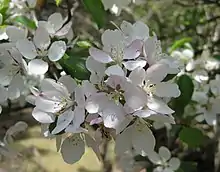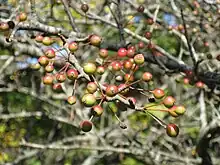Malus spontanea
Malus spontanea, the nokaidō, is a species of crabapple in the family Rosaceae, found only in the Ebino-kōgen high plateau of the Kirishima volcanic complex of Kyushu, Japan.[2][1] It is closely related to Malus halliana, currently found in the wild in China, and considered possibly originally native to Japan.[2] Fewer than 300 individuals survive in the wild.[2]
| Malus spontanea | |
|---|---|
 | |
| Close-up of flowers | |
 | |
| Fruit | |
| Scientific classification | |
| Kingdom: | Plantae |
| Clade: | Tracheophytes |
| Clade: | Angiosperms |
| Clade: | Eudicots |
| Clade: | Rosids |
| Order: | Rosales |
| Family: | Rosaceae |
| Genus: | Malus |
| Species: | M. spontanea |
| Binomial name | |
| Malus spontanea | |
| Synonyms[1] | |
|
Sinomalus spontanea (Makino) Rushforth | |
References
- "Malus spontanea (Makino) Makino". Plants of the World Online. Royal Botanic Gardens, Kew. Retrieved 24 March 2022.
- Iketani, Hiroyuki; Mase, Nobuko (2013). "Exploration and Collection of two Crabapple species, Malus spontanea Makino and "Takanabe kaidō," in Southern Kyūshū, Japan" (PDF). 植探報. 29: 119–125. Retrieved 24 March 2022.
This article is issued from Wikipedia. The text is licensed under Creative Commons - Attribution - Sharealike. Additional terms may apply for the media files.